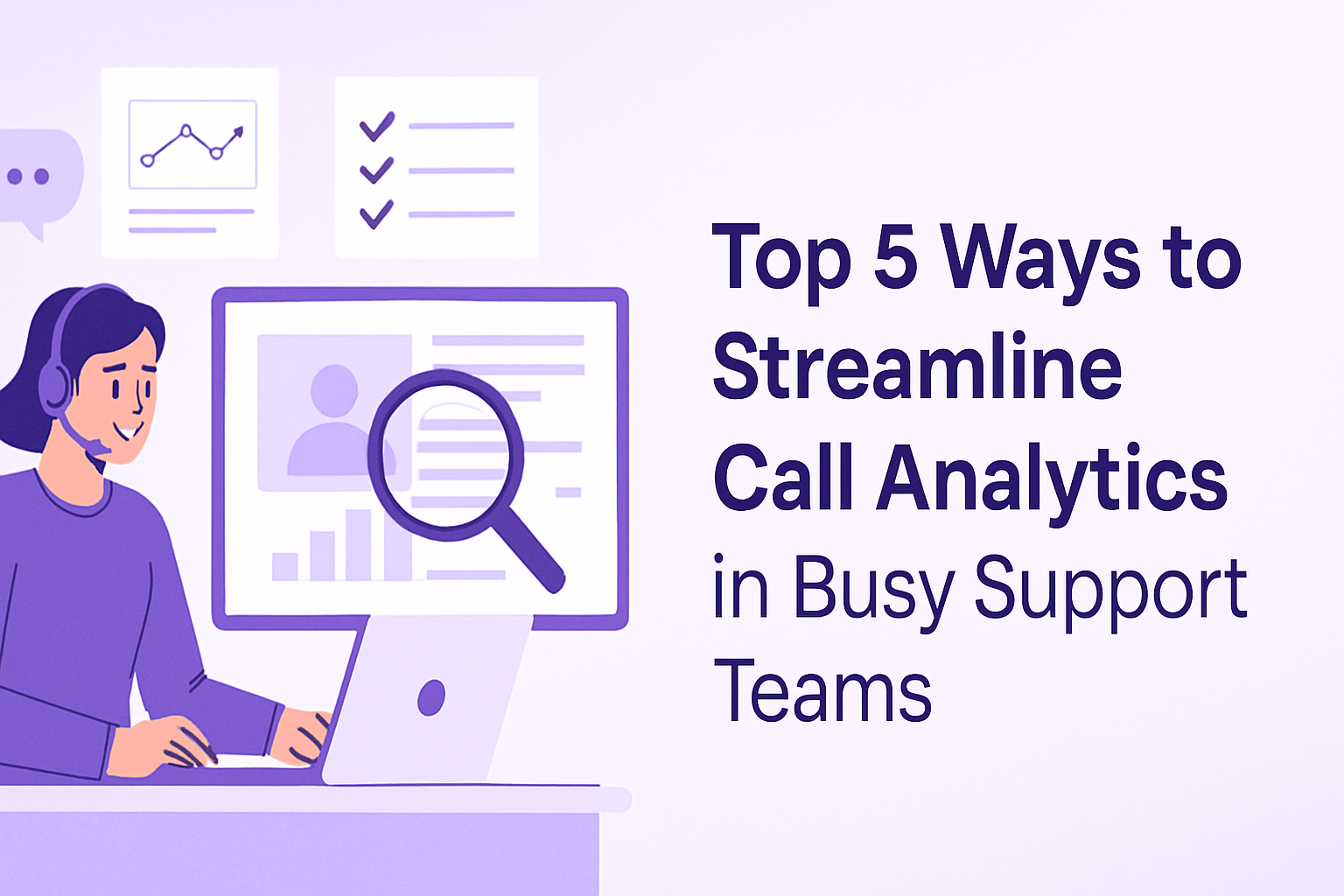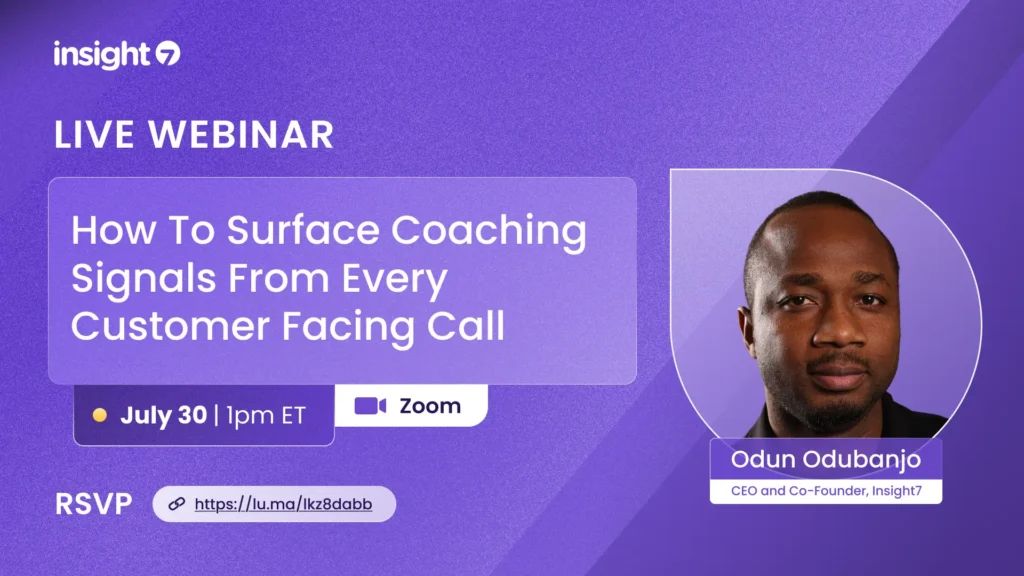7 Key Insights from Combining Call Analytics with Voice-of-Customer Data
-
Hello Insight
- 10 min read
7 Key Insights from Combining Call Analytics with Voice-of-Customer Data
Understanding customer needs is crucial for every B2B organization, especially when it comes to product development and go-to-market strategies. By effectively combining call analytics with voice-of-customer (VoC) data, businesses can unlock powerful insights that drive impactful decisions. This guide explores seven key insights that emerge from this combination, highlighting how organizations can benefit from improved data analysis and decision-making processes.
The Role of Call Analytics and VoC Data in Modern B2B Organizations
In today’s competitive landscape, businesses must adapt to customer feedback quickly to remain relevant. Integrating call analytics with VoC data has become essential for organizations looking to leverage customer insights for product development and marketing strategies.
The fundamental mechanism behind this approach is the analysis of conversations and feedback across various channels. This not only shifts organizations from reactive to proactive strategies but also automates tedious manual processes. By fostering alignment across sales, marketing, and customer service teams, companies can create a unified approach to customer experience.
To effectively combine these insights, organizations need robust technology solutions that can analyze data from diverse sources, such as Salesforce, Gong, Slack, and HubSpot.
What is Call Analytics and Voice-of-Customer Data?
Call analytics refers to the process of collecting and analyzing data from customer interactions via phone calls. This includes metrics such as call duration, response times, and customer sentiment analysis. Voice-of-customer data encompasses insights derived from customer feedback across various channels, helping organizations understand customer preferences, pain points, and expectations.
This approach differs from traditional methods, as it allows organizations to look forward—anticipating customer needs and behaviors—rather than merely reflecting on past interactions.
Core Capabilities: Combining call analytics and VoC data enables organizations to:
- Identify trends and patterns in customer behavior
- Enhance customer segmentation based on feedback
- Drive targeted marketing strategies
- Improve agent training and performance
- Inform product development decisions with real-time insights
Strategic Value: This combination supports proactive decision-making, allowing teams to collaborate effectively and align their strategies according to customer needs.
Why Are Consultants and Insight-Seeking Personnel Investing in Call Analytics and VoC Data?
Context Setting: As businesses strive for customer-centric operations, the shift from outdated methods to more integrated approaches is vital. Traditional methods often fail to provide actionable insights due to data silos, manual analysis, and lack of real-time information.
Key Drivers:
- Inefficiency of Traditional Methods: Relying on manual analysis of disparate data sources leads to delayed insights and missed opportunities.
- Speed to Market: The need for timely insights allows organizations to respond to market changes and customer demands quickly.
- Personalization: Tailoring products and services based on comprehensive customer insights enhances customer satisfaction and loyalty.
- Data-Driven Optimization: Businesses seek to optimize their operations by leveraging accurate, real-time data for decision-making.
What Data Powers Call Analytics and VoC Insights?
Foundation Statement: To build reliable models that inform business decisions, organizations require a diverse array of data sources.
Data Sources:
- Call Transcripts: Textual data from conversations that provide context and sentiment.
- Customer Feedback Forms: Structured feedback gathered through surveys and forms.
- CRM Systems: Data from platforms like Salesforce that track customer interactions.
- Social Media: Insights from customer interactions across social platforms to gauge sentiment and trends.
- Email and Chat Logs: Records of customer interactions through email and chat services.
Accuracy Benefit: A multi-modal approach increases the accuracy of insights, enabling organizations to make informed decisions based on a comprehensive understanding of customer behavior.
Key Components of a Call Analytics and VoC Data Stack
Stack Overview: The integration of call analytics and VoC data involves several critical layers that enable effective analysis and decision-making.
Component Descriptions:
- Data Collection: Tools that capture data from calls, customer feedback, and social interactions.
- Natural Language Processing (NLP): Analyzes text and speech to derive sentiment and intent.
- Dashboard and Reporting Tools: Visualize insights and performance metrics for various teams.
- Machine Learning Algorithms: Identify patterns and predict customer behaviors based on historical data.
- Integration Capabilities: Connect with existing systems like Salesforce and HubSpot for seamless data flow.
Quality Emphasis: Ensuring high-quality data inputs and outputs is critical for deriving meaningful insights that drive business outcomes.
Success Dependency: The effectiveness of this approach relies heavily on the quality and diversity of input signals.
How Does Combining Call Analytics and VoC Data Work Step by Step?
Step 1: Data Collection
Gather call data and VoC feedback from various sources, including CRM systems and feedback forms.
Step 2: Data Processing
Utilize NLP technologies to convert audio and text data into actionable insights, identifying key themes and sentiments.
Step 3: Insight Analysis
Analyze the data to identify patterns, such as common customer complaints or requests.
- Sentiment Analysis: Understanding customer emotions based on call interactions.
- Trend Identification: Recognizing emerging patterns in customer feedback.
- Performance Metrics: Evaluating agent performance against customer satisfaction scores.
Step 4: Training and Learning
Leverage historical data to train agents, enhancing their skills based on real customer interactions.
Step 5: Real-Time Processing
Implement systems that provide real-time analytics during customer interactions, allowing for immediate adjustments.
Step 6: Output and Recommendations
Deliver insights through dashboards or reports that inform product development and marketing strategies.
- Example Output 1: Identifying opportunities for new product features based on customer feedback.
- Example Output 2: Highlighting areas where customer service can be improved.
- Example Output 3: Providing training recommendations based on agent performance metrics.
Where Can Consultants and Insight-Seeking Personnel Apply Call Analytics and VoC Data?
Identifying Customer Needs
- Analysis Approach: Use call analytics to discover common themes in customer feedback.
- Recommended Action: Adjust product features based on identified needs.
Improving Agent Performance
- Scoring Method: Assess agent interactions through quality metrics derived from calls.
- Follow-Up Action: Provide targeted training to agents based on their performance scores.
Enhancing Customer Experience
- Identification Method: Track sentiment trends over time to gauge customer satisfaction.
- Proactive Scheduling: Implement improvements in service based on feedback.
Optimizing Product Development
- Forecasting Approach: Analyze customer feedback to predict future product needs.
- Optimization Action: Align product roadmaps with customer expectations.
What Tools Can You Use for Call Analytics and VoC Data?
When considering platforms for call analytics and VoC data integration, look for solutions that offer comprehensive capabilities and user-friendly interfaces.
Comparison Table:
| Feature | Insight7 | Traditional Alternative |
|---|---|---|
| Call Recording | Yes | Limited |
| Sentiment Analysis | Advanced | Basic |
| Real-Time Insights | Yes | Delayed |
| Data Integration | Seamless | Manual |
| Reporting Tools | Customizable | Static |
Common Pitfalls in Call Analytics and VoC Data Implementation
Context Warning: Organizations often make mistakes when implementing call analytics and VoC data strategies due to a lack of understanding of the process.
Major Pitfalls:
- Data Silos: Failing to integrate data sources can lead to incomplete insights.
- Inadequate Training: Without proper training, teams may struggle to utilize insights effectively.
- Ignoring Quality Control: Poor data quality can distort insights and lead to misguided decisions.
- Neglecting Stakeholder Alignment: Lack of collaboration between departments can hinder overall effectiveness.
Success Foundation: Avoiding these pitfalls starts with a clear strategy that emphasizes cross-functional collaboration.
How Do You Get Started with Insight7?
Step 1: Integration Capability
Connect Insight7 with existing systems such as Salesforce and HubSpot to streamline data flow.
Step 2: Data Synchronization
Synchronize call data and customer feedback to create a unified dataset.
Step 3: Configuration Options
Customize settings to fit your organization’s specific needs and objectives.
Step 4: Training Process
Use historical data to train teams on interpreting and leveraging insights.
Step 5: Customization Options
Allow different stakeholders to tailor dashboards and reports according to their needs.
Step 6: Ongoing Optimization
Regularly review and refine processes based on new data and insights.
What Is The Best Call Analytics and VoC Data Setup?
ROI Optimization: To ensure maximum return on investment, organizations should adopt best practices in data management and analysis.
Best Practices:
- Diverse Data Requirement: Ensure data is collected from multiple sources for comprehensive insights.
- Stakeholder Involvement: Engage various departments to align strategies and objectives.
- Historical Data Timeframe: Utilize data from an appropriate timeframe to identify trends accurately.
- Review Cadence: Establish regular review meetings to assess insights and adjust strategies.
- Automation Integration: Automate data collection and reporting to save time and resources.
Building a Call Analytics and VoC Data Strategy That Scales
A scalable strategy for combining call analytics and VoC data begins with cross-functional alignment. Teams should collaborate on defining objectives, data sources, and key performance indicators. Implementing a robust feedback loop allows organizations to continuously refine their strategies based on real-time insights.
Call Analytics and VoC Data Benchmarks and Success Metrics
Evaluation Framework: Clear benchmarks are necessary to measure the impact of combined call analytics and VoC data.
Core Metrics:
- Customer Satisfaction Score (CSAT): Measures customer satisfaction levels after interactions.
- Net Promoter Score (NPS): Gauges customer loyalty and likelihood to recommend.
- First Call Resolution Rate: Tracks the effectiveness of resolving customer issues on the first contact.
- Agent Performance Metrics: Evaluates individual agent performance based on quality and customer feedback.
- Trend Analysis: Identifies shifts in customer sentiment and preferences over time.
Universal Principle: The ultimate goal is to derive actionable insights that lead to better decisions and improved customer experiences.
Frequently Asked Questions
Q: What is call analytics?
A: Call analytics is the process of collecting and analyzing data from customer phone calls to gain insights into customer behavior and agent performance.
Q: How does this differ from traditional methods?
A: Unlike traditional methods that focus on historical data, combining call analytics with VoC data allows for real-time insights and proactive decision-making.
Q: What platforms are compatible with Insight7?
A: Insight7 integrates seamlessly with popular CRM systems like Salesforce and HubSpot, as well as communication tools like Slack and Gong.
Q: What data sources are ideal for effective analysis?
A: The best results come from diverse data sources, including call transcripts, customer feedback, CRM systems, and social media interactions.
Q: How long does it take to implement this strategy?
A: The timeline can vary, but organizations can expect to see initial insights within weeks of integration, depending on the complexity of the data.
Q: What security measures are in place to protect data?
A: Insight7 adheres to industry-standard security protocols and compliance regulations to ensure data protection and privacy.






